10 Poisonous Snakes in Australia
#mobileSnakeQuizControls { overflow: hidden; text-overflow: ellipsis; white-space: nowrap; }
@media (min-width: 481px) {
.mobile-top-content {
display: none;
}
}
#mobileTopContentCTACarouselControls { overflow: hidden; text-overflow: ellipsis; white-space: nowrap; }
.mobile-top-content .more { color: #fff; }
.mobile-top-content a { color: #fff; text-decoration: underline; }
.mobile-top-content a:hover { color: #fff; text-decoration: underline; }
@media (max-width: 480px) {
.mobile-top-content {
background-color: #06a10b;
color: #fff;
text-align: center;
/*height: 60px;
padding-top:5px;*/
font-size:80%;
/* display: block; */
margin: 0px -30px;
}
}
Australia is famous for its unique animal population – especially snakes. Containing over 170 species of land snakes, of which about 100 are venomous, it is believed that Australia’s large landmass and varying climates provide diverse habitats for these animals to thrive. 85% of the world’s most venomous snakes, including the top three most venomous snakes in the world – the inland taipan snake, the eastern brown snake, and the coastal taipan snake – can be found in Australia.
You should, however, note that even though these terms are often used interchangeably, ‘poisonous’ and ‘venomous’ don’t mean the same thing. By venomous, we mean a bite from any of these snakes is capable of producing a highly potent toxin that enters the body to induce life-threatening symptoms or cause death in attacked victims. Contrary to ‘poisonous’ which only depicts that eating a toxic animal can cause harm. Therefore, snake bites are actually venomous, not poisonous.
So, here’s a list of 10 venomous snakes in Australia – starting from the least to the incredibly venomous!
button.pulse {
transform: scale(1); animation: pulse 2s infinite;
box-shadow: 0 0 0 0 rgba(11, 247, 25, 1);
}
@keyframes pulse {
0% { transform: scale(0.90); box-shadow: 0 0 0 0 rgba(11, 247, 25, 0.5); }
60% { transform: scale(1); box-shadow: 0 0 0 15px rgba(11, 247, 25, 0); }
100% { transform: scale(0.90); box-shadow: 0 0 0 0 rgba(11, 247, 25, 0); }
}
10. Small-eyed Snake (Cryptophis nigrescens)
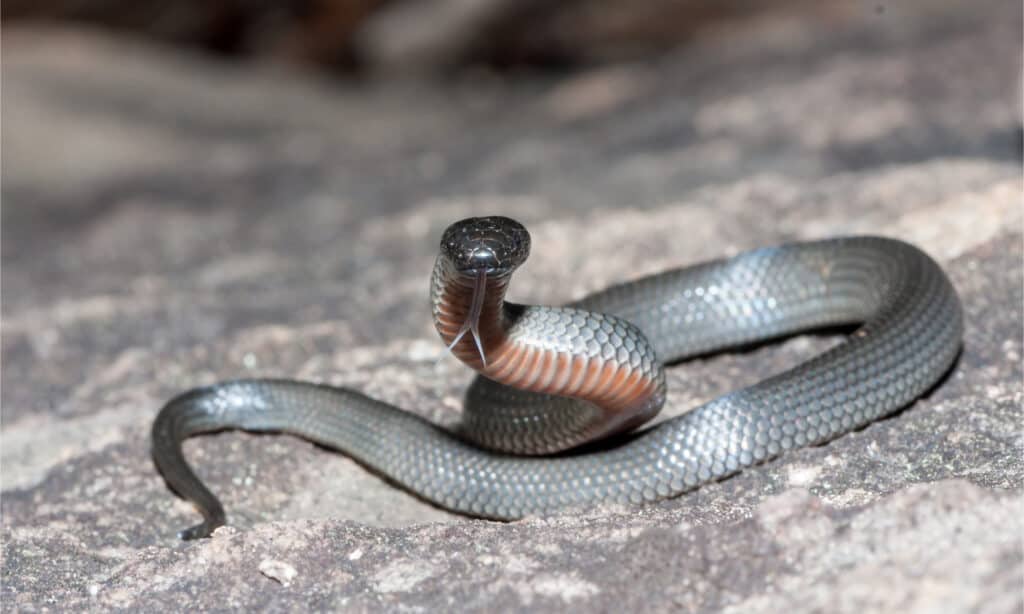
Ken Griffiths/Shutterstock.com
The small-eyed snake is a species of venomous snake endemic to eastern Australia, from the southern Cape York Peninsula to Victoria. This snake species has a slightly flattened head and small, dark-colored eyes which gives it its name. It is a dangerous Australian snake with a venom containing strong myotoxin which attacks the victim’s muscle tissues even for days after the bite. A bite from a small-eyed snake should always be treated by first aid and urgent medical attention should be sought as quickly as possible.
9. Red-Bellied Black Snake (Pseudechis porphyriacus)
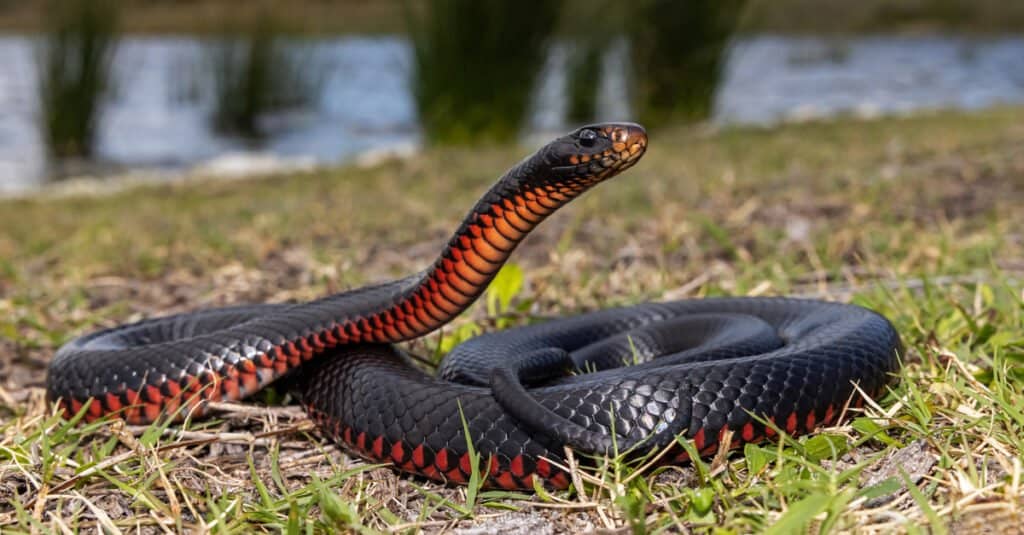
Ken Griffiths/Shutterstock.com
One of the snakes most commonly encountered on the east coast of Australia, the red-bellied snake is highly venomous, although less venomous than other Australian elapid snakes. The name refers to its glossy black top body, bright red or orange flanks, and duller red belly. Despite being considered one of the most dangerous snakes in Australia, the red-bellied black snake is known to be non-aggressive and generally retreats from human encounters, but will attack if provoked. Its bite accounts for 16% of recorded identifiable snakebite victims in Australia, though no deaths have been recorded yet.
8. Lowland Copperhead (Austrelaps superbus)
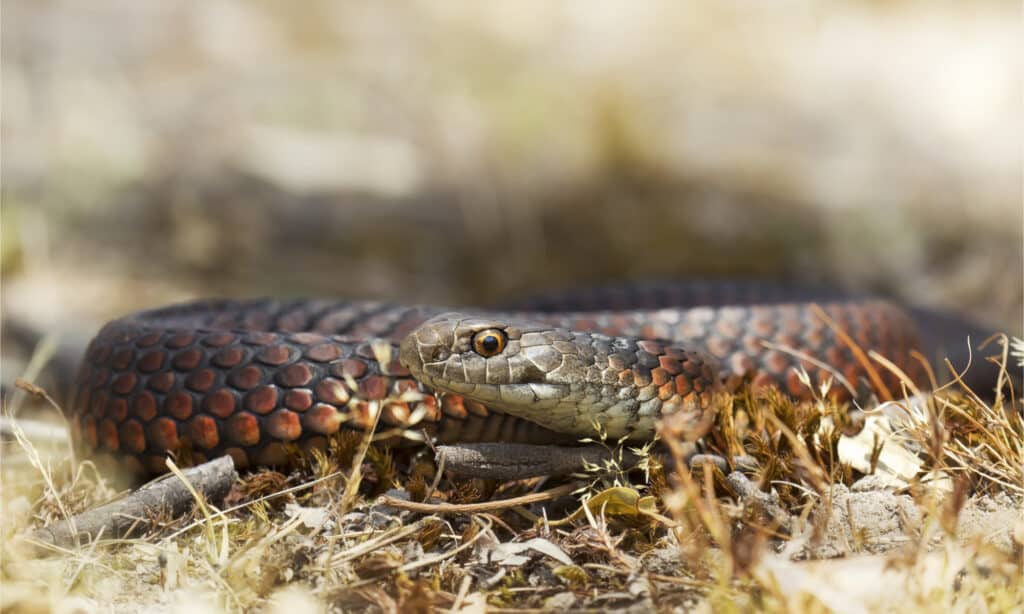
Austrelaps superbus/Shutterstock.com
Lowland copperheads are found in southeastern Australia, including the coldest regions where most other snakes wouldn’t survive. They prefer to live in low vegetation areas near water bodies where they can prey on frogs, lizards, and other snakes. Lowland copperheads are dangerous snakes with neurotoxic and hemotoxic venom, and one bite is enough to kill an adult human if no medical assistance is provided immediately. They generally prefer to avoid human encounters but will attack and bite upon further provocation.
7. Mulga Snake (Pseudechis australis)
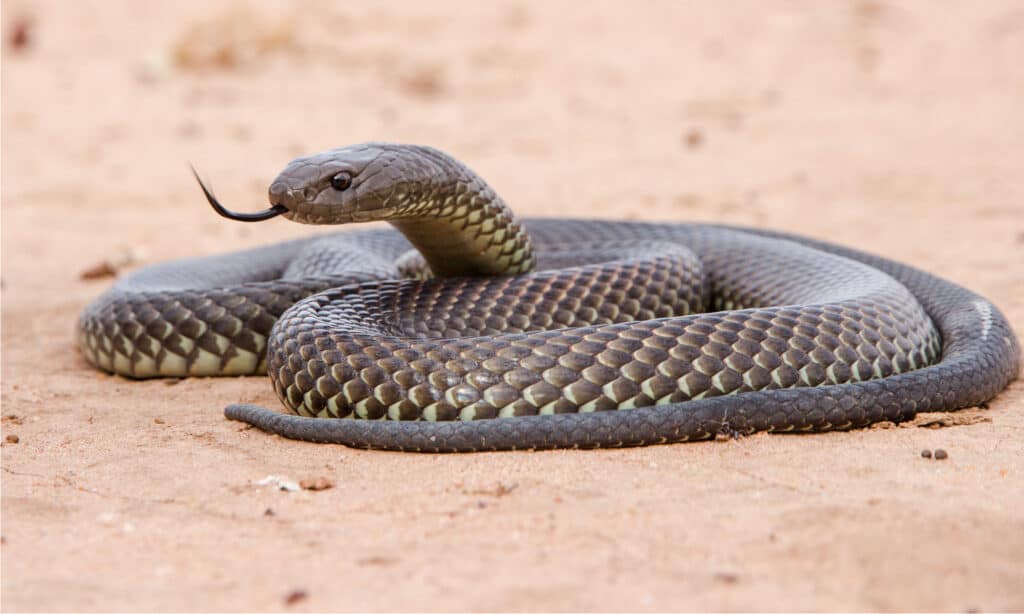
Ken Griffiths/Shutterstock.com
Mulga snake, alternatively known as king brown snake, is another species of venomous snake native to western, northern, and central Australia. The mulga snake is responsible for 4% of recorded identified snake bite attacks in Australia. Even though its venom is not as potent as those of Australia’s other venomous snakes, deaths from its bites have been recorded. When delivered in large quantities, the mulga snake’s venom has major effects – causing muscle paralysis and extensive pain and swelling of the bite site. In rare cases, death can occur. A large king brown snake delivers on average 180 mg of venom in one bite!
6. Western Brown Snake (Pseudonaja nuchalis)

Kristian Bell/Shutterstock.com
The western brown snake is also called ‘Gwadar’ meaning “go the long way around” – a piece of advice to anyone who comes across this snake. Why? Because it is a dangerous species known to defend itself when threatened even though it is generally considered to be non-aggressive. The western brown snake’s bite is highly toxic and has been known to cause human fatalities. This species of very fast, highly venomous snake is present across the north of Australia. It is usually found hiding in crevices and under rocks.
5. Common Death Adder (Acanthophis antarcticus)
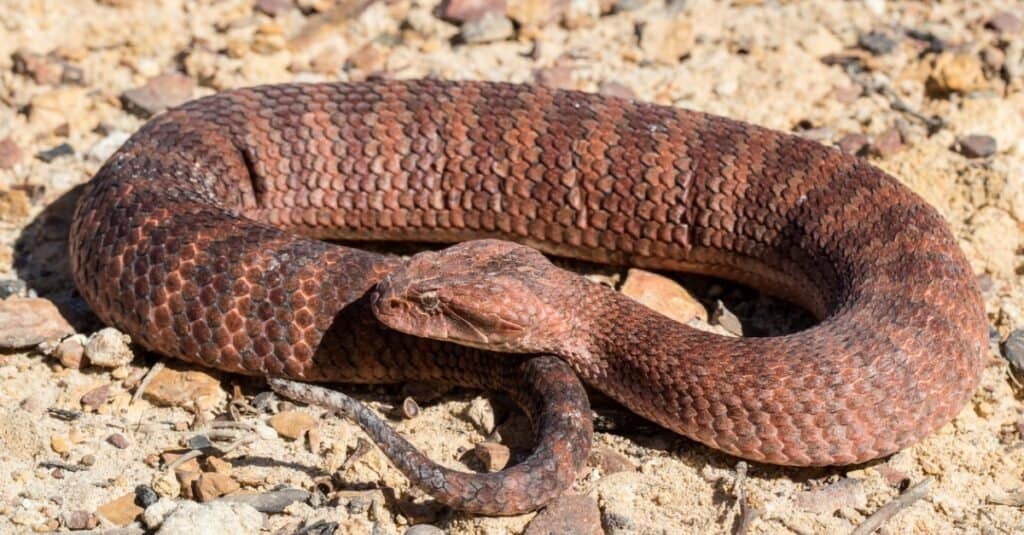
iStock.com/Ken Griffiths
With a name that can send shivers down anyone’s spine, the common death adder is one of the most venomous land snakes in Australia and the world. The ‘death’ in this snake’s name is not a bluff – the common death adder can deliver the fastest strike among all venomous snakes recorded in Australia. It is capable of causing human death within six hours after a bite. While its body is broad and short with a thin tail that gives it the appearance of a viper, it has an average fang length of 6.22 mm (0.24 in) – the longest fangs of any Australian snake!
4. Mainland Tiger Snake (Notechis scutatus)

Michal Pesata/Shutterstock.com
Mainland tiger snakes have distinctive black and yellow bands, like a tiger. When threatened, they assume a classic threat pose; their bodies become flattened and they raise their heads above the ground. They are highly venomous and potentially fatal to humans. In a study, 17% of identified snakebite victims in Australia were found to be caused by tiger snakes. This snake is often found in southern Australia and Tasmania, including coastal regions near wetlands, creeks, dams, and watercourses.
3. Coastal Taipan Snake (Oxyuranus scutellatus)
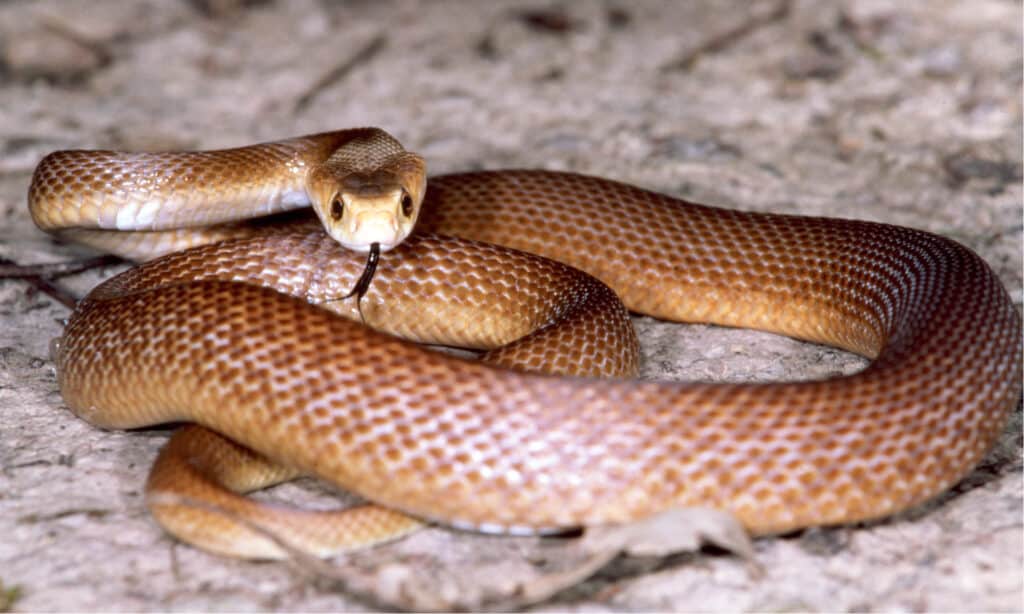
Ken Griffiths/Shutterstock.com
The second-longest venomous snake in Australia after the king brown snake, the coastal taipan grows up to about 6.6 ft in length, with the longest individuals reaching 9.5 ft in length. It is the third most venomous terrestrial snake in Australia after the inland taipan and eastern brown snake. Widely feared in history, a coastal taipan produces an average venom yield of 120mg, with a maximum record of 400 mg obtained from some specimens. Due to how dangerous and aggressive the coastal taipan snake is, it is classified as a snake of medical importance by the World Health Organization.
2. Eastern Brown Snake (Pseudonaja textilis)

Ken Griffiths/Shutterstock.com
Found along the east coast of Australia, the eastern brown snake has a slender body build and can grow up to 7 feet in length. You’ll easily identify this snake by its pale brown with a pale cream-yellow underside often with orange or grey splotches. But don’t be deceived by its cool appearance – this is the world’s second-most venomous land snake and one of the deadliest snakes in the world! It is responsible for about 60% of human snake-bite deaths in Australia. The eastern brown snake is so venomous that the WHO also classified it as a snake of medical importance.
1. Inland Taipan (Oxyuranus microlepidotus)
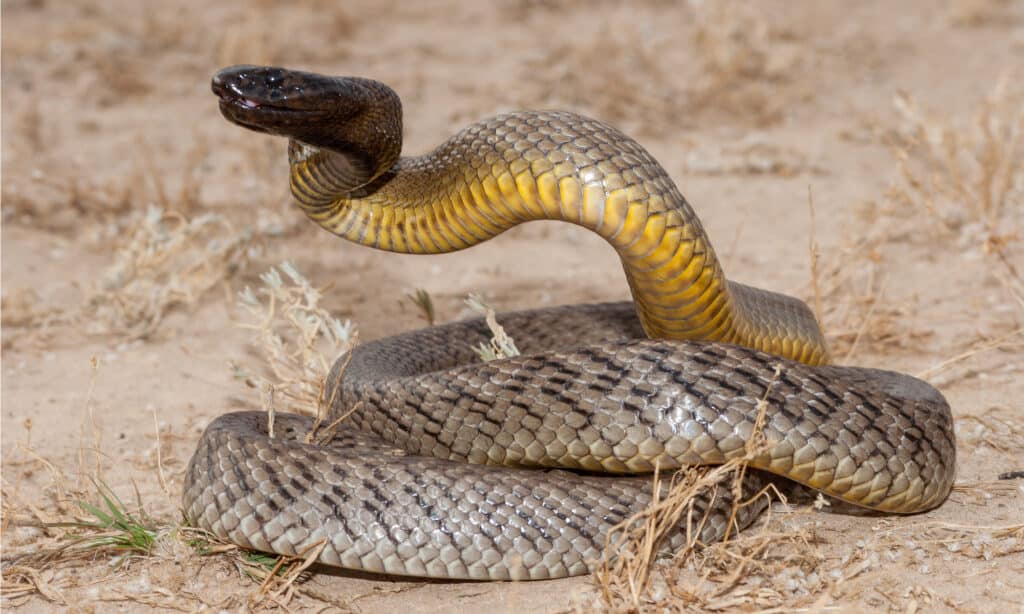
Ken Griffiths/Shutterstock.com
The inland taipan is the most venomous of any snake in Australia, and even in the world – even more than the popularly feared sea snakes. This extremely venomous snake species is endemic to semi-arid regions of central east Australia. It averages approximately 5.9 feet and has a dark tan appearance. It is an extremely fast and agile snake, attacking with extreme accuracy when provoked. Its highly toxic venom is said to be the most potent of any terrestrial snake in the world. One bite from the inland taipan has enough venom to kill at least 100 fully grown humans!
Discover the “Monster” Snake 5X Bigger than an Anaconda
Every day A-Z Animals sends out some of the most incredible facts in the world from our free newsletter. Want to discover the 10 most beautiful snakes in the world, a “snake island” where you’re never more than 3 feet from danger, or a “monster” snake 5X larger than an anaconda? Then sign up right now and you’ll start receiving our daily newsletter absolutely free.
More from A-Z Animals
.more-snake-card-image { max-height:140px !important; }
#mobileSnakeQuizControls { overflow: hidden; text-overflow: ellipsis; white-space: nowrap; }
@media (min-width: 481px) {
.mobile-top-content {
display: none;
}
}
#mobileTopContentCTACarouselControls { overflow: hidden; text-overflow: ellipsis; white-space: nowrap; }
.mobile-top-content .more { color: #fff; }
.mobile-top-content a { color: #fff; text-decoration: underline; }
.mobile-top-content a:hover { color: #fff; text-decoration: underline; }
@media (max-width: 480px) {
.mobile-top-content {
background-color: #06a10b;
color: #fff;
text-align: center;
/*height: 60px;
padding-top:5px;*/
font-size:80%;
/* display: block; */
margin: 0px -30px;
}
}
Australia is famous for its unique animal population – especially snakes. Containing over 170 species of land snakes, of which about 100 are venomous, it is believed that Australia’s large landmass and varying climates provide diverse habitats for these animals to thrive. 85% of the world’s most venomous snakes, including the top three most venomous snakes in the world – the inland taipan snake, the eastern brown snake, and the coastal taipan snake – can be found in Australia.
You should, however, note that even though these terms are often used interchangeably, ‘poisonous’ and ‘venomous’ don’t mean the same thing. By venomous, we mean a bite from any of these snakes is capable of producing a highly potent toxin that enters the body to induce life-threatening symptoms or cause death in attacked victims. Contrary to ‘poisonous’ which only depicts that eating a toxic animal can cause harm. Therefore, snake bites are actually venomous, not poisonous.
So, here’s a list of 10 venomous snakes in Australia – starting from the least to the incredibly venomous!
button.pulse {
transform: scale(1); animation: pulse 2s infinite;
box-shadow: 0 0 0 0 rgba(11, 247, 25, 1);
}
@keyframes pulse {
0% { transform: scale(0.90); box-shadow: 0 0 0 0 rgba(11, 247, 25, 0.5); }
60% { transform: scale(1); box-shadow: 0 0 0 15px rgba(11, 247, 25, 0); }
100% { transform: scale(0.90); box-shadow: 0 0 0 0 rgba(11, 247, 25, 0); }
}
10. Small-eyed Snake (Cryptophis nigrescens)

Ken Griffiths/Shutterstock.com
The small-eyed snake is a species of venomous snake endemic to eastern Australia, from the southern Cape York Peninsula to Victoria. This snake species has a slightly flattened head and small, dark-colored eyes which gives it its name. It is a dangerous Australian snake with a venom containing strong myotoxin which attacks the victim’s muscle tissues even for days after the bite. A bite from a small-eyed snake should always be treated by first aid and urgent medical attention should be sought as quickly as possible.
9. Red-Bellied Black Snake (Pseudechis porphyriacus)

Ken Griffiths/Shutterstock.com
One of the snakes most commonly encountered on the east coast of Australia, the red-bellied snake is highly venomous, although less venomous than other Australian elapid snakes. The name refers to its glossy black top body, bright red or orange flanks, and duller red belly. Despite being considered one of the most dangerous snakes in Australia, the red-bellied black snake is known to be non-aggressive and generally retreats from human encounters, but will attack if provoked. Its bite accounts for 16% of recorded identifiable snakebite victims in Australia, though no deaths have been recorded yet.
8. Lowland Copperhead (Austrelaps superbus)

Austrelaps superbus/Shutterstock.com
Lowland copperheads are found in southeastern Australia, including the coldest regions where most other snakes wouldn’t survive. They prefer to live in low vegetation areas near water bodies where they can prey on frogs, lizards, and other snakes. Lowland copperheads are dangerous snakes with neurotoxic and hemotoxic venom, and one bite is enough to kill an adult human if no medical assistance is provided immediately. They generally prefer to avoid human encounters but will attack and bite upon further provocation.
7. Mulga Snake (Pseudechis australis)

Ken Griffiths/Shutterstock.com
Mulga snake, alternatively known as king brown snake, is another species of venomous snake native to western, northern, and central Australia. The mulga snake is responsible for 4% of recorded identified snake bite attacks in Australia. Even though its venom is not as potent as those of Australia’s other venomous snakes, deaths from its bites have been recorded. When delivered in large quantities, the mulga snake’s venom has major effects – causing muscle paralysis and extensive pain and swelling of the bite site. In rare cases, death can occur. A large king brown snake delivers on average 180 mg of venom in one bite!
6. Western Brown Snake (Pseudonaja nuchalis)

Kristian Bell/Shutterstock.com
The western brown snake is also called ‘Gwadar’ meaning “go the long way around” – a piece of advice to anyone who comes across this snake. Why? Because it is a dangerous species known to defend itself when threatened even though it is generally considered to be non-aggressive. The western brown snake’s bite is highly toxic and has been known to cause human fatalities. This species of very fast, highly venomous snake is present across the north of Australia. It is usually found hiding in crevices and under rocks.
5. Common Death Adder (Acanthophis antarcticus)

iStock.com/Ken Griffiths
With a name that can send shivers down anyone’s spine, the common death adder is one of the most venomous land snakes in Australia and the world. The ‘death’ in this snake’s name is not a bluff – the common death adder can deliver the fastest strike among all venomous snakes recorded in Australia. It is capable of causing human death within six hours after a bite. While its body is broad and short with a thin tail that gives it the appearance of a viper, it has an average fang length of 6.22 mm (0.24 in) – the longest fangs of any Australian snake!
4. Mainland Tiger Snake (Notechis scutatus)

Michal Pesata/Shutterstock.com
Mainland tiger snakes have distinctive black and yellow bands, like a tiger. When threatened, they assume a classic threat pose; their bodies become flattened and they raise their heads above the ground. They are highly venomous and potentially fatal to humans. In a study, 17% of identified snakebite victims in Australia were found to be caused by tiger snakes. This snake is often found in southern Australia and Tasmania, including coastal regions near wetlands, creeks, dams, and watercourses.
3. Coastal Taipan Snake (Oxyuranus scutellatus)

Ken Griffiths/Shutterstock.com
The second-longest venomous snake in Australia after the king brown snake, the coastal taipan grows up to about 6.6 ft in length, with the longest individuals reaching 9.5 ft in length. It is the third most venomous terrestrial snake in Australia after the inland taipan and eastern brown snake. Widely feared in history, a coastal taipan produces an average venom yield of 120mg, with a maximum record of 400 mg obtained from some specimens. Due to how dangerous and aggressive the coastal taipan snake is, it is classified as a snake of medical importance by the World Health Organization.
2. Eastern Brown Snake (Pseudonaja textilis)

Ken Griffiths/Shutterstock.com
Found along the east coast of Australia, the eastern brown snake has a slender body build and can grow up to 7 feet in length. You’ll easily identify this snake by its pale brown with a pale cream-yellow underside often with orange or grey splotches. But don’t be deceived by its cool appearance – this is the world’s second-most venomous land snake and one of the deadliest snakes in the world! It is responsible for about 60% of human snake-bite deaths in Australia. The eastern brown snake is so venomous that the WHO also classified it as a snake of medical importance.
1. Inland Taipan (Oxyuranus microlepidotus)

Ken Griffiths/Shutterstock.com
The inland taipan is the most venomous of any snake in Australia, and even in the world – even more than the popularly feared sea snakes. This extremely venomous snake species is endemic to semi-arid regions of central east Australia. It averages approximately 5.9 feet and has a dark tan appearance. It is an extremely fast and agile snake, attacking with extreme accuracy when provoked. Its highly toxic venom is said to be the most potent of any terrestrial snake in the world. One bite from the inland taipan has enough venom to kill at least 100 fully grown humans!
Discover the “Monster” Snake 5X Bigger than an Anaconda
Every day A-Z Animals sends out some of the most incredible facts in the world from our free newsletter. Want to discover the 10 most beautiful snakes in the world, a “snake island” where you’re never more than 3 feet from danger, or a “monster” snake 5X larger than an anaconda? Then sign up right now and you’ll start receiving our daily newsletter absolutely free.







